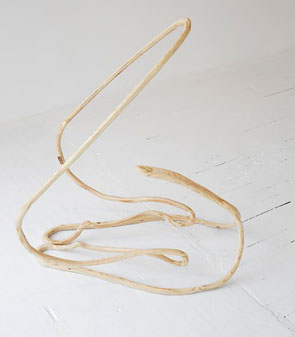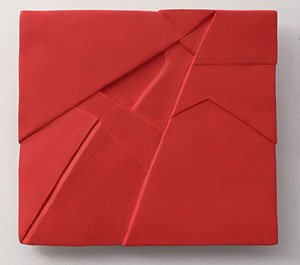A Body of Art
John Haberin New York City
John Dante Bianchi, Monika Zarzeczna, and Elizabeth Jaeger
Bruce M. Sherman, Lee Relvas, and Elaine Cameron-Weir
Abstraction is back, even as craft is celebrated as art. John Dante Bianchi, for one, makes painting and Monika Zarzeczna sculpture, as bare and plain as day. Elizabeth Jaeger and Bruce M. Sherman make ceramics polished and wild. Lee Relvas gives plywood the grace of fine furniture, and Elaine Cameron-Weir makes lab equipment smell. So why do all six appear to fragment or to extend human flesh?
Avoidance behavior
John Dante Bianchi called his show "Unavoidable Encounter." I would not have had it any other way. With Monika Zarzeczna, I had a less fortunate encounter, but just as unavoidable.  At least the dealer assured me so when I apologized: I was only the latest to dislodge a work from the wall. It had fallen three times at the opening alone.
At least the dealer assured me so when I apologized: I was only the latest to dislodge a work from the wall. It had fallen three times at the opening alone.
I am not convinced: I should have been more careful. Still, both artists expose their materials to the elements for good reason. They lay bare a work's construction, with what others might dismiss as unfinished. They also ask one to compare its fragility to one's own. Save taped lines on the floor for museums.
Both make art between painting and sculpture—or between painting and its frame. Bianchi creases his rectilinear surfaces, so that they protrude that much further into the room. Often he folds or peels them back as well, revealing the stretcher and the space within it as a further intrusion into depth. Painting comes off the wall while also returning to the wall. He recalls Minimalism's talk of art as object, with a geometry determined by its edges, only here the hard edges fall within the painting rather than along the borders of stretched canvas. The lines in three dimensions also contrast with the freer handling of paint and the unpredictable overall shape.
His rejection of formalism extends to the blurred, layered, and mottled surfaces. He does not lean strictly to flesh tones, but the pinks, blues, and creams mean to evoke human skin. He sands or scars aluminum and plywood panels to increase the interpenetration of color, with the bruising both literal and a metaphor. Where Minimalism obliged one to look to oneself and one's surroundings, here both appear vulnerable. White sculpture in the center of the room looks more like stalagmites. Does that make the panels cave paintings?
Zarzeczna comes across as more of a craftsperson, but not for long. Here the wood looks shaped and bent like an old rocker. It could be Cubism's still life with chair caning without the caning. In practice, though, she simply cuts away at found scraps and connects them, with the hardware visible as with Robert Ryman. They also serve as stretchers for battered Plexiglas or aluminum and spattered paint, only the panels have mostly fallen to the floor. Normally, aluminum flashing protects houses from damage by water, but things are less stable than they appear.
If one had any doubts, a small weight on the floor keeps the sole freestanding work from sliding or toppling over. Once again a work's support becomes part of its materials and imagery. Its larger scale compared to wall pieces also keeps it from becoming precious. Others include bundled horsehair and twine, hanging down or holding (for now) a smaller construction to the wall. They suggest brooms and human hair, as further marks of housekeeping and personal exposure. Should they fall, they can take on the task of sweeping up.
Saddling up
If you want to elevate a medium associated more with craft than art, some might say, you have two choices. You can make it artier, or you can make it funkier—anything, in other words, to destroy its use value. When it comes to ceramics, I could be speaking of its leading lights, in Ken Price and Arlene Shechet. Yet it also describes Elizabeth Jaeger and Bruce M. Sherman. As it happens, their galleries share an entrance on the Lower Side, and ascending the two-tier space is all about exploring the possibilities. Yet they also share a fascination with the medium and the human body.
 Jaeger offers one body after another, and they do not look happy. Female torsos lie draped over steel bars as if skinned alive. The lack of heads and feet underscores the objectification of women in her art and, by extension, a dominant art and culture—and she has in the past portrayed the sex act and animals. The sheer array adds to the anonymity of its subjects, and the slices lead to an asymmetric placement of breasts that adds to the discomfort. They avoid big boobs, too, refusing to play to male expectations. If they offer any comfort, it is in a woman's art.
Jaeger offers one body after another, and they do not look happy. Female torsos lie draped over steel bars as if skinned alive. The lack of heads and feet underscores the objectification of women in her art and, by extension, a dominant art and culture—and she has in the past portrayed the sex act and animals. The sheer array adds to the anonymity of its subjects, and the slices lead to an asymmetric placement of breasts that adds to the discomfort. They avoid big boobs, too, refusing to play to male expectations. If they offer any comfort, it is in a woman's art.
Still, there is no getting around the art and craft. They retain the smooth surfaces of both female beauty and stoneware, with neither scars nor blood. The slim black bars and their twin supports are just as elegant and minimal. Jaeger calls the installation Pommel, evoking the saddle shapes, as if women should expect to be ridden, and the pummeling of naked flesh. Yet it also evokes gymnastic equipment, with women capable of athleticism and grace. Besides, the word alone sounds sophisticated.
Sherman takes things back to ceramics in another way—not with stoneware but with its shapes. One or two even look like vases. Yet he makes them fun, funky, and punning. They have sharp edges, irregular outlines, and bright colors from their glazing. They morph easily into bodies or architecture, like castles, and in real life both are inhabited. A woman's face appears on the vase.
One could call the opposition modern and postmodern, much as for Price and Shechet, although those categories are as slippery as ever. Price has his contoured shapes, but speckled with color and riddled with cuts, like Isamu Noguchi or Constantin Brancusi and his tea ceremony after an encounter with pattern and decoration. Shechet has her crusty textures and Pop imagery, but also a closer approach to tradition—because now, after Modernism and the demand to "make it new," anything from any time is available. She curates a collection of Rococo porcelain and her own at the Frick. Jaeger and Sherman recap a similar history, but with a difference. Here the modernist is the imagist, the feminist, and the threat.
Then, too, history keeps reversing expectations. Modernism embraced design and use from the very start and, by the end, industrial materials. The present, in turn, has been relishing fine design and folk art, including tapestry. Altoon Sultan has three concurrent approaches to abstract art—in rug-hooked and hand-dyed wool, porcelain bas reliefs, and egg tempera. The tapestries have the nested geometry of Minimalism, while the paintings and sculpture borrow from both industrial parts and the Renaissance sculpture of Lorenzo Ghiberti, and she titles one work Convergence. Jaeger in particular, though, makes all the possibilities personal, pressing, and one.
Riding for a fall
It can be just one step from grace to a fall. Ask athletes or dancers about their last titanic leap. Ask Hillary Clinton about the ten days before the election. Or ask Lee Relvas, whose sculpture seems poised between a glorious ascent and collapse. Her figures have all the grace of athleticism or a dance, but always in touch with the floor. They also have an inner life that would be impossible without that rise and fall.
Her technique alone evokes both grace and the workaday dignity of just plain plodding along. Her curved wood comes as close as anything to Modernism's ideal of "drawing in space," as with sculpture by Ibram Lassaw. One can mistake it for the fine craft of bentwood furniture. In practice, though, Relvas cuts her pieces from plywood, sticks them together with a compound used for joints in plumbing, and sands away. The process is itself a kind of choreography. Plywood is already soft as wood goes, and rubbing softens it further—close, she says, to flour.
It works just fine as abstraction, like wood for Ursula von Rydingsvard. One can delight in following a curve from its start to the end, looping back on itself. One can easily overlook the branching here and there. Still, it does not take long to see a room of people, neither quite together nor alone. Some seem to sink into helplessness, while others seem to rise, and more than a few do both. Still another amounts to rigid planes joined at the waist, where a further loops around like the sash of an old-fashioned dress.
One can read all sorts of things into them, including their narratives and their character. Relvas does, too. The firm or, if you prefer, matronly stance is Deciding. Others are Hiding, Withholding, Thinking, Offering, Mourning, and Lifting. In each case, she associates a physical gesture with a state of mind—a state poised between moments of action. She treats exterior form and interiority alike as transient and fleeting.
Elaine Cameron-Weir, too, would love to rise but keeps stumbling, in the lobby of the New Museum. A snake of copper and stainless steel needs a sandbag to sustain its vertical. Mostly, though, she is hooked on art and the body as, in her eyes, at once transcendent and corrupt. A garment of metal sports breasts and spreads its arms, but it looks less triumphant than an instrument of torture. A pole topped with a skull and a lamp draped with parachute silk look neither life affirming nor all that illuminating. Then again, a snake brought corruption to humanity as well, by tempting a certain woman.
The Canadian artist is fond of the body all the same, enough to aspire to engage the senses, with some of the same materials as Anicka Yi. Heat lamps warm a resin used in perfumes and fumigating. If all this seems like a lab experiment gone awry, she also claims to draw on scientific texts from before modern science, to locate the tensions between the occult and science. And if her art starts to sound like nonsense, so do her titles. One runs to forty-two words—including viscera, erogenous zone, altered state, subcutanean, and tantric. It could do with less messaging and more grace.

John Dante Bianchi ran at Denny through January 22, 2017, Monika Zarzeczna at Lesley Heller through March 19, Elizabeth Jaeger at Jack Hanley through April 16, Bruce M. Sherman at Nicelle Beauchene through April 16, Altoon Sultan at McKenzie through March 26, Lee Relvas at Callicoon Fine Arts through May 21, and Elaine Cameron-Weir at the New Museum through September 3.




